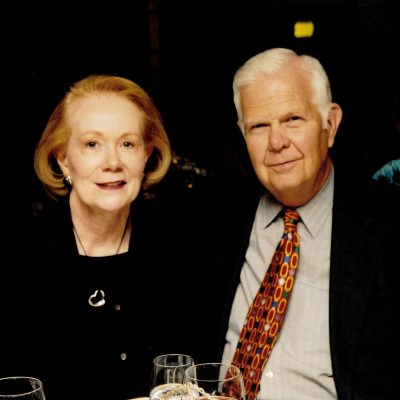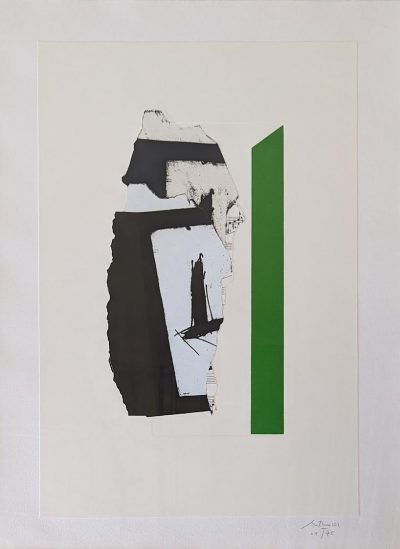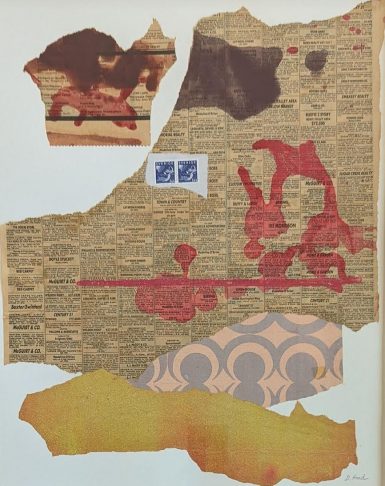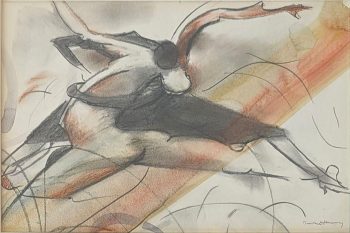A Passion for Collecting:
The Shirley and Donald Rose Gift
By Cammie Tipton, Assistant Curator, Public Art UHS
Inside her elegant garden home in Montrose, seated with her small dog Rosie in her lap, Shirley Rose discusses how her love of art began at a young age. She tells of when she was in her twenties, how she transported an inexpensive poster of Vermeer’s Milkmaid around with her for years, from place to place. “I do love Vermeer,” she remarks in a dreamy tone and adds that she still reads about him today. Unsurprisingly, Rose became an avid collector of modern art ranging from Joan Miró to Ben Shahn. Her collection of extraordinary works on paper, include rare original drawings from such significant artists as Henry Moore and Dorothea Tanning, as well as collages from Robert Motherwell and Dorothy Hood. As we walk through her living room, passing one of Brassaï’s famous nightlife photographs and a small birdhouse-like sculpture by Leonardo Drew, we head upstairs as Mrs. Rose tells her story on how she amassed such an eclectic collection. She remarks that the impetus to collect begins with the desire to feel as close as possible to the artwork itself.
Rose is quick to acknowledge the great support she was given by her husband, Donald Rose, for what she calls her “passion for collecting.” She says she has always been the great art lover while her husband Donald graciously went along with her pursuit. She did not set out with any strategic collecting plan and states with a smile that the entire endeavor “was all just seat of the pants.” Whenever she and Donald encountered a work they liked, they would do a little reading on it before making any purchasing decisions. She remembers, “we never bought anything that we did not know something about or that piqued our interest.”

After earning her B.S., M.Ed., and Ph.D. in Education from the University of Houston, Rose sought a career in education, serving as superintendent for Harris County Department of Education for many years. She describes how she would leave work each day, driving on the 610 loop towards the East End, and she would pass the Hooks-Epstein Gallery in Montrose, one of Houston’s longest running and most established art galleries. Curious, she stopped by to visit one day and quickly established a friendly and trusted relationship with the gallerist Charles Epstein. Remembering fondly, Rose says, “I began my love of art collecting by visiting Charles at Hooks on a regular basis.” She says it was Charles’ own love for art that really inspired her passion to collect. Recalling their many gallery talks, Rose remembers fondly, “I would drive in there on my way home and Charles was very patient with me and he would educate me.”
One of the first major artworks she collected was a piece that her husband Don particularly liked—an original drawing by the eccentric and rule-breaking New York artist Larry Rivers. Rose describes how, in the late 70s or early 80s, she and Don were visiting Dubose Gallery in Houston, where they spotted the drawing from Rivers, titled Ace of Spades, and bought it directly from the gallery. Rivers depicted everyday popular items—such as this playing card—while injecting a historical (and sometimes figurative) approach to his work that was wildly unpopular at the time, making him a known renegade of the art world.
After acquiring this original drawing from Rivers, Shirley immediately felt an itch to find more of his work and began informing local Houston galleries of her intentions: “I’d say, we’re going to New York, and I’d like to see some Larry Rivers.” From there, an exchange between the Houston and New York galleries would begin. She was informed that a New York gallery had a Rivers work that she might like, and she went to see it in person. The work was another original drawing—this time a larger sketch, rendered in soft pastel colors—of a Camel cigarette box, titled Smoking. The artist recreated this motif again and again, in different variations, throughout the 70s and 80s, marking this work as a seminal piece of Rivers’ oeuvre.
While galleries were her usual method of education and collecting, Rose would also occasionally find items she loved at museums and in auctions. Along with Hooks-Epstein Gallery, Rose has held relationships with other local arts organizations such as FotoFest, the Blaffer Art Museum, and the Museum of Fine Arts, Houston’s Collector’s Group, that have helped to foster her passion for collecting. She particularly speaks admirably of the renowned photography curator Anne Tucker at the Museum of Fine Arts whose passion for photography drew Rose into the museum. Admitting that she did not initially know much about photography, it was Anne Tucker’s enthusiasm that inspired Rose to collect a few exceptional pieces such as a superb Bill Brandt print of the streets of London during WWII.


It was only after years of amassing works on paper from many celebrated modern artists, that the Roses began to see a pattern in the collection. When viewing her living room and the artworks displayed salon-style upon a light peach wall, a bold contrast of black and white became apparent throughout the collection. She remarks on the black and white theme, declaring, “It just sort of came together that way.” Following her instincts instead of a prescribed collecting method, Rose remembers that she and her husband said, “We should get some more color in the house but we instinctively always chose black and white.”
This inclination towards a minimal black and white aesthetic was a natural match for the modern art that was prevalent in New York at midcentury. The New York School was in many ways initiated by the young intellectual artist Robert Motherwell. Rose explains how she was introduced to the artist himself through the Collector’s Group at the Museum of Fine Arts, Houston. Upon meeting him, she recalls, “He was such a character.” The deceptively simple aesthetic of The New York School appealed to her, as she states, “I like things that are sort of simplistic. I don’t have anything that’s really complex.” Of Motherwell’s work, she was attracted to one piece in particular, In White with Green Stripe, because it contains a small, nearly hidden, section of tiny musical notes. With these musical notes, surrounded by larger similar black markings, Motherwell asks us to question what an artist’s simple black lines are capable of. In the corner of Rose’s living room stands her beloved piano, stacked high with art books—Henri Cartier-Bresson, David Hockney, and Georgia O’Keefe among others—and she talks about the piano lessons she took as a young girl and says she has always enjoyed the sound of the piano. The Motherwell is hung directly above the piano.
To be sure, Rose does not conform to a particular taste, nor does she feel the need to obey any rules of collecting. While New York modernists and canonical classics appear in the collection, there are also several contemporary and experimental artists as well. As she was amassing her collection, there was plenty of admirable art being made in her own Houston backyard, and Rose sought to support local artists as well. Her fine collection of Texas artists include the sculptor James Surls—a large black and white flower print adorns her living room wall—the multimedia artist Al Souza—an early fragmented “puzzle painting” hangs in her bedroom—and a collage from Dorothy Hood. As one of the few recognized women artists of the Abstract Expressionist period, Hood’s Houston practice would solidify her reputation as a boundary-blurring member of the AbEx movement. In her later years, Hood enjoyed the whimsy and playfulness of creating small paper collages.
Along with Hood, several other women artists take prominent positions in the collection. A particularly stunning piece is an original drawing by the Surrealist artist Dorothea Tanning, titled Overtime. The drawing depicts two undefined figures—in classic black and white—in a questionable embrace, washed over by a wide rainbow. Again, it was the Hooks-Epstein Gallery that facilitated the acquisition of this special piece. Remarking on Tanning herself, Rose remarks, “She was always overshadowed by her husband.” As a young talented artist, Tanning married Max Ernst and, while enjoying a favored life in the international art world, a full recognition of her own artwork went largely neglected. Accompanying this drawing is a copy of Tanning’s own autobiography, Birthday (1986), released the same year as this drawing was created. The book is signed by Tanning and addressed to Rose on the inside cover.


As mentioned, many local arts institutions have facilitated Rose’s collection over the years, and she has maintained a special relationship with the University of Houston’s Blaffer Art Museum where she serves as a lifetime member of their advisory board. Rose speaks delightedly of her relationship with the former directors Terrie Sultan and Claudia Schmuckli and how they helped to nurture her love of art and her collecting practice. Terrie Sultan’s brother is the New York artist Donald Sultan, of which Rose collected three prominent prints after meeting the artist in his New York City studio. A large black and white photograph from Sultan’s Smoke Rings series hangs in a prominent position in Rose’s living room. She bought the piece after Terrie called her following Donald’s exhibition at the Blaffer. As she speaks about acquiring the piece, Rose looks upon the photograph and says, “When I see this hanging on my wall, I think, I’m so happy that I have that.”
As a collector, sometimes you simply get lucky. One year at Blaffer’s annual gala and auction, Rose found herself the winner of the auction prize, which turned out to be an unusually small sculpture by the installation artist Leonardo Drew. The charming piece was made specifically by Drew for the auction, rendering it a one-of-a-kind sculpture that Rose displays on a singular small shelf in her kitchen.
Art collecting can undoubtedly be an emotionally fraught and expensive enterprise. Collecting can be taken up for many different reasons: whether the love of art, or simply a means of investment, or the thrill of the chase, or pure obsession. Rose makes certain that she began collecting because she wanted to surround herself with the art that she loved—spending every day with the art was a means to feel more closely connected to it in a way that public viewership simply does not allow. Rose was determined to surround herself with her favorite art and she purposefully sought out to collect a few special pieces. As an example of this, she points upwards towards a Matisse print hung above her living room entryway. The print, titled Odalisque Au Collier, displays one of Matisse’s famous Odalisques from his Orientalist phase that he drew after extensive trips through North Africa in the early 1900s. Rose says, “Matisse has always been my love really.” While she yearned to collect something created by him, she knew she could not afford a painting. She found that prints are a good option for someone with a more judicious budget.
Original artworks, especially those created by established artists, are certainly not inexpensive and Shirley admits to loving art “on a minimal budget.” For this, some of the pieces—the Henry Moore and one of the Larry Rivers—were paid for in installments to the gallery, with a little down payment to begin with to secure the piece. Rose also explains how being a shrewd negotiator does not hurt—sometimes after a gallery show she would find herself on the phone with the artist, bargaining the price of an artwork.
This special art collection from Dr. Shirley Rose is an extraordinary gift to the University of Houston, the institution that afforded her years of fine education as well as great opportunities in her career and her ongoing art interests. In this gifting back to the University, the Shirley and Donald Rose Collection will be on permanent view around the University campus to inspire and educate students, faculty, staff, and the local community. The gift greatly enhances the University’s Public Art collection and we are thankful for her generosity. Dr. Shirley Rose has graciously served the Houston arts community through such organizations as the Blaffer Art Museum Advisory Board, Moore’s Society Trustee, the Kathrine G. McGovern College of the Arts Dean’s Trustee, the Alley Theatre Board of Advisors, and the University of Houston’s In Tempore Legacy Society.
